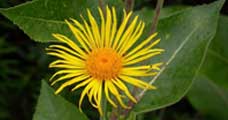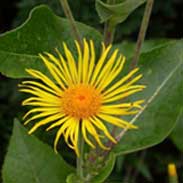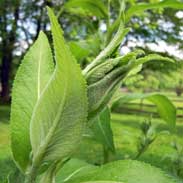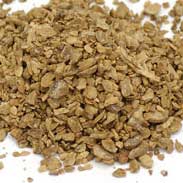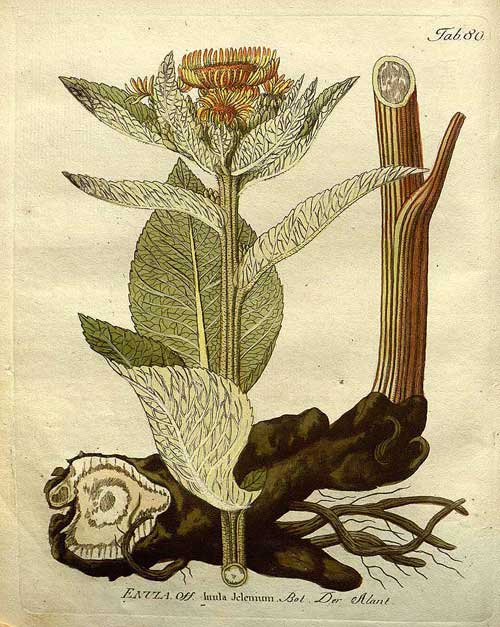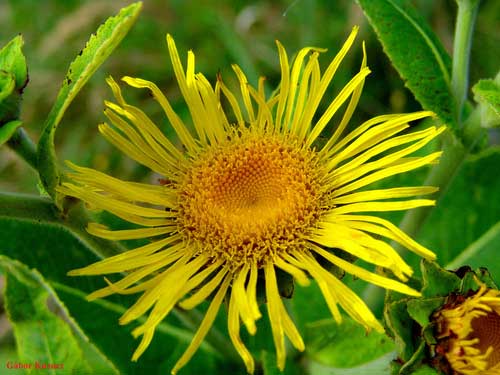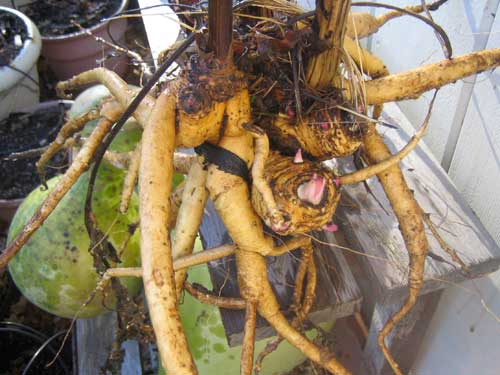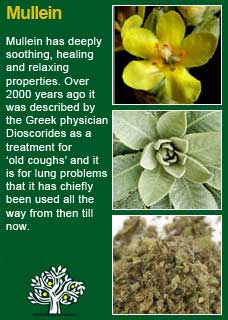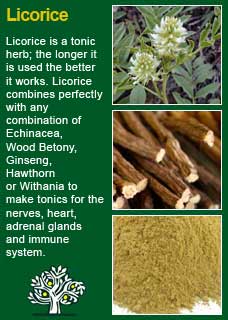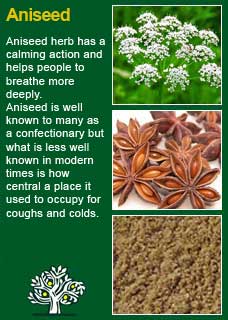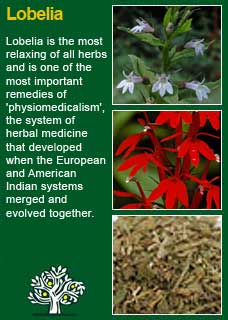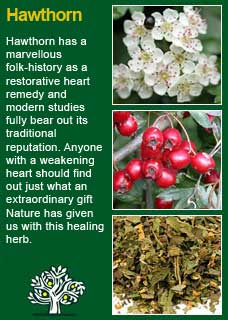
|
|
||||
| Our Pages ABOUT CONSTITUTIONAL MEDICINE
|
The roots of Elecampane; long-lived plant whose stems grow up to 2 meters high and then support clusters of distinctive bright yellow flowers. Elecampane was also once known as ‘Elfwort’ because it was sacred to the ancient Celts and Druids.
One of Elecampane's common names 'Horseheal' was derived from its use by veterinarians in treating lung disorders in horses. The Latin name 'Helenium' comes from the legend of Helen of Troy who was said to be carrying the plant when abducted by Paris. Elecampane root was one of the chief remedies for advanced chest diseases and has a long record for clearing old coughs, especially of tuberculosis. It has also been widely used a treatment for cold, congested conditions such as arthritis, rheumatism and bronchial conditions. The 'father of medicine' Hippocrates said Elecampane stimulates the brain, kidneys, stomach and uterus and the great Roman naturalist Pliny wrote 'let no day pass without eating some roots of Elecampane to help digestion, expel melancholy and cause mirth'. Traditional Chinese and Indian Ayurvedic physicians used Elecampane to treat respiratory problems, particularly bronchitis and asthma. Nicholas Culpeper wrote 'Elecampane relieves cough, shortness of breath and wheezing in the lungs' and he also claimed it 'cures worms in the stomach'. Avicenna, in his Canon of Medicine, one of the most influential medical books in history, writes of Elecampane as being heating and drying. He says "Elecampane is useful in all kinds of cold pains, severe gas troubles and flatulence. It purifies the lungs and belongs to a class of drugs which are attenuant and strengthening for the heart" King's Dispensatory writes 'Elecampane is an aromatic stimulant and tonic, and is much used in chronic pulmonary affections and weakness of the digestive organs. Night-sweats are relieved by Inula, as are some cases of humid asthma, and, by its tonic properties, it tends to sustain the strength of the patient in chronic disorders of the respiratory tract. Inula is somewhat slow in action, and should be used for quite a time to get its full action. That it is an important remedy in irritation of the trachea and bronchiae is now well established. It is adapted to cases with free and abundant expectoration, teasing cough, and pain beneath the sternum, conditions frequent in the grippe, and the severer forms of colds' The British Herbal Pharmacopoeia (BHP) describes the actions of Elecampane as 'expectorant, antitussive, diaphoretic, bactericidal' and says it is indicated for 'bronchial or tracheal catarrh, cough of pulmonary tuberculosis, irritating cough in children and specifically indicated for 'irritating cough of bronchitis, phthisis (a wasting disease of the lungs such as caused by tuberculosis) The BHP recommends doses of 1.5-4 grams or by decoction or 1.5-4ml of the liquid extract. Thomas Bartram writes that the actions of Elecampane include 'antispasmodic, alterative, stimulating expectorant, diaphoretic, antiseptic, stomachic, anticatarrhal'. He suggests uses for it including 'has a long record for old coughs, especially of tuberculosis, haemoptysis (the coughing up of blood), whooping cough, croup, advanced chest diseases to facilitate removal of mucus, emphysema, chronic catarrh, night sweats, to strengthen a feeble digestion, stitches in the side (from the spleen) and hyperventilation' Bartram says it combines well in the popular combination with Marshmallow and Yarrow and recommends doses of 1-2mls of the liquid extract and a quarter to half a tsp of the cut root to each cup of water, gently simmered 10 minutes in a covered vessel. H Felter writes 'Inula is of greatest service in bronchial irritation, with cough of a persistent, teasing character, with copious expectoration. We have for many years used and valued the syrup advised by Locke, and prepared as follows: Take Elecampane, 1 ounce; Boiling Water, 16 fluidounces. Boil until but 8 ounces remain; add 1/2 pound of white sugar. This is especially useful in chronic bronchitis, with profuse excretion of mucus or muco-pus, and in the cough persisting after la grippe and the severest forms of colds. TJ Lyle writes 'Elecampane root is a gently stimulating tonic to the mucous membrane. Diaphoretic, diuretic and expectorant, it is warming, strengthening, cleansing, and toning to the gastric, intestinal and pulmonary mucous membrane, and is very serviceable in catarrhal conditions of the bronchi, and catarrhal dyspepsia. It is better suitable to chronic than acute cases'
~ Evidence supports the traditional reputation for Elecampane being effective for coughs, colds and in the bronchial tubes and the lungs. The roots and rhizomes contain sesquiterpene lactones that have been shown to have potent healing, antiseptic and relaxant properties (British Herbal Medicine Association: British herbal compendium, Bournemouth, 1992, BHMA) ~ An extract from Elecampane (eudosmanolides) demonstrated ulcer healing properties, relieved symptoms and improved gastric mucosal circulation in a clinical trial with 102 patients with peptic ulcer disease (Luchkova MM: Fiziolohichnyi Zh 23(5): 1977, 686-687) ~ Experiments with extracts of Elecampane in the laboratory showed it to have potent antibacterial activity against an array of infectious organisms, including Staphylococcus aureus, Enterococcus faecalis, Escherischia coli, Pseudomonas aeruginosa, and Candida albicans (Stojakowska, A., Kedzia, B., and Kisiel, W. Antimicrobial activity of 10-isobutyryloxy-8,9-epoxythymol isobutyrate. Fitoterapia 2005;76(7-8):687-690) ~ European scientists have shown that Elecampane contains a substance (alantolactone) that helps rid the body of intestinal parasites (Cantrell CL et al: Planta Med 65(4):351-355, 1999) ~ In studies with people, Elecampane extracts prevented ST-segment depression and T-wave inversion in patients with ischemic heart disease (Tripathi, Y. B., Tripathi, P., and Upadhyay, B. N. Assessment of the adrenergic beta-blocking activity of Inula racemosa. J Ethnopharmacol. 1988;23(1):3-9) ~ Elecampane has been shown to have a beneficial effect on angina pectoris (Tripathi, S. N., Upadhyaya, B. N., and Gupta, V. K. Beneficial effect of Inula racemosa (pushkarmoola) in angina pectoris: a preliminary report. Indian J Physiol Pharmacol. 1984;28(1):73-75) ~ The authors, titles and the 'where-and-when' published of nearly 40 further studies and articles on Elecampane are listed in a PDF found here
For some years now, against this proven and safe way of herbalism, there has been a rising tide of excessive caution and scare-mongering in many parts of the world. The same authorities that, not so long ago, decried herbal medicines as ineffectual, have now taken up a different adversarial position; that they are dangerous substances that should only be prescribed by Doctors, who of course have zero training in them. Unfortunately, the same unnecessary fear and worry has crept into many natural health websites and popular publications on herbs. Herbs that we have safely used for thousands of years, that have no reports of adverse reactions in the medical literature despite widespread use by millions of people, are suddenly described as contraindicated because of something that should have been seen as completely unimportant, or at the utmost a merely theoretical concern, such as a laboratory study on one of the herb's constituents to use an all too common example. I wonder sometimes if the writers of such articles feel that the herb will be more deserving of respect if it is thought to be a little bit dangerous, in other words more like a drug than something that has simply come out of the earth and been used by ordinary people for generations beyond count. There is just so much misinformation about herbal medicine on the internet now. Ludicrous claims and cautions abound in equal measure; it seems like one group are trying to make money out of the public whilst the other are busily trying to scare them off. I have to believe that the kind of reader who takes the time to read pages on herbs that are as extensive as this one is much less likely to be swayed by marketers or misinformers. I hope that you will keep your wits about you if you get conflicting opinions from people who have never really got to know these herbs, who have never worked with them, or learned how to use them safely and effectively. I want to remind you that the reason that herbs can never be patented and owned by any individual or corporation is because they are, and always will be, the People's medicine. They belong to all of us and it is my great hope in sharing this work that you will learn how to use them wisely for yourself, and the people you care for. Be safe, but do not be afraid.
I have personally come to a deep respect for the healing power of Elecampane, not from any fast-acting miracles but rather from the phenomena of how this great herb actually strengthens the lungs. Some years ago, I obtained an electronic stethoscope that is able to accurately record the sound of the heart (and the breathing when needed) which can then save that sound in a computer file that can be called up to compare a 'before and after' in a subsequent appointment. This technology has enabled me to confirm something what can happen when Elecampane is used as a tonic over a decent period of time (i.e. at least a few months to gain its full benefits). Any kind of long-term respiratory problem causes the lungs to become audibly strained and weakened; there is a noticeable sound of ‘effort’ which you can hear through the stethoscope; it is distinctly out of harmony with how effortless a healthy breath should sound. My observation is that Elecampane, slowly but surely, literally strengthens the lungs; you can compare it and you can hear it. We don't know how it happens, although the science suggests a variety of ways the herb might influence the tissues of the lungs, the more important point is that it clearly does help and I would recommend, without hesitation, to anyone who has a history of asthma, chronic bronchitis or general weakness in their breathing, to give Elecampane a proper and sustained trial for themselves. High doses of Elecampane are not necessary and probably inadvisable given this is such a potent herb. Equally one must take enough for it to keep exerting its therapeutic action every day and for most people I would say that would be around 2 or 3 mls of the tincture, perhaps a little more in a person who needed higher doses of substances in general to feel their effects. I do also very much like to use Elecampane as a tea equally as much as the tincture and I find that just a gram or two a day that has been well extracted into water conveys great benefits, again so long as it is taken patiently and consistently. This is a true tonic herb which means the longer you take it the better it works... If you who are reading this are studying herbal medicine or have your own reasons to want to get to know this great plant ally in much more depth then I warmly recommend you take a small dose of its tea or tincture and then, with a quiet and attentive mind, observe for yourself what then happens as the herbs 'action' becomes apparent in your body. Like any kind of relationship, everyone has their own impressions when they do this kind of experiential learning but the common themes that come up with Elecampane is how deeply it penetrates into the core, how lingering are its effects and how it palpably opens up the lungs and somehow lifts the spirits in the process. Further to this, if you would like to learn more about the ancient art of pulse testing, a simple but powerful way to ask the intuitive intelligence of the body for its responses to a herb by feeling the pulse whilst giving a tiny dose by mouth, read here Elecampane combines perfectly with Mullein and Licorice to help clear the lungs and with Aniseed and Lobelia to release spasm and constriction in the chest. It can also be a tremendous ally with Hawthorn when a person has become generally weakened in their heart and lungs - in such cases the long-term use of the two herbs together can be nothing short of life-changing.
Much of the information here about the traditional uses of Elecampane is consistent with the model of thinking whereby one may treat problem A with plant B. There is value in this approach, especially in how it helps us pass on useful knowledge to one another, but it falls short in one vital area; and that is that people are not all cut from the same cloth! Something that works brilliantly for one person may do less for another -- why is this? Part of the reason is that people vary in their constitutions as to whether they are either hotter or cooler and, at the same time, either dryer or damper. This useful and rather fascinating subject is introduced further here Another big part of using the right herb when it is most needed comes from understanding the need to treat what is going wrong for the person that had led up to their getting a health condition. In this light, Elecampane can particularly offer its benefits when a cleansing action is needed in the 'cycle of healing', more about this here
Please understand that I cannot advise you, including on products or dosage, without seeing you in person in my clinic but for ideas
on how you might find a good herbalist in your area read here |
|
|
© 2011 R.J.Whelan Ltd
